13 Purple Plants to Grow for Bold Color
From lavender to amethyst, flowers in every shade of purple make a stunning addition to any landscape.
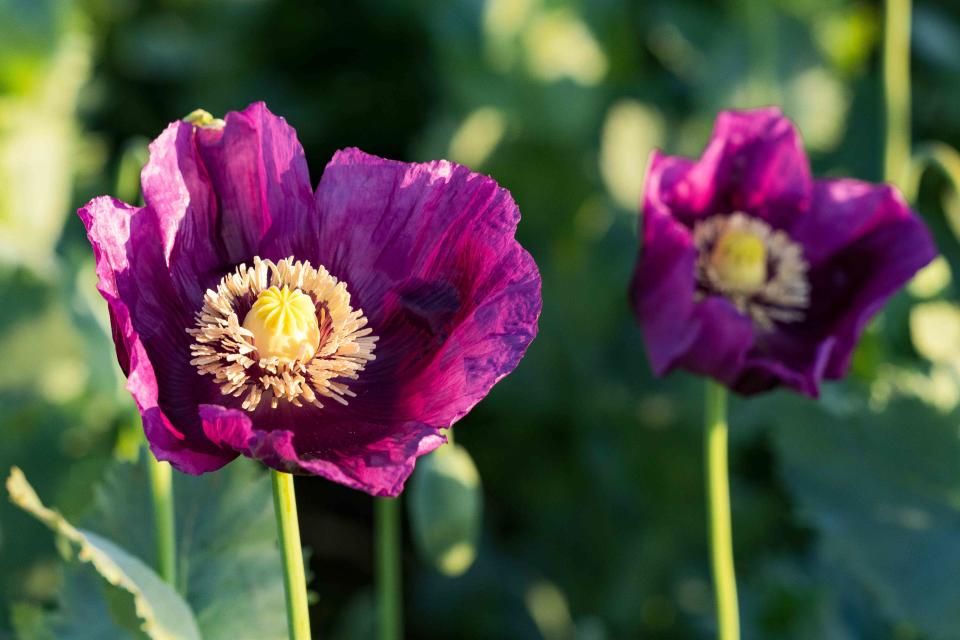
Landscapes, nature, macro / GETTY IMAGES
No matter what look you're trying to achieve in your landscape, there is a purple plant that fits your design aesthetic. From soothing pastels to dramatic amethyst, incorporating purple in your yard is always a good idea—especially if you're hoping to introduce some bold color to your green space. To help you get inspired, we're sharing the most visually striking purple plants to grow now. Whether you're looking for container plants to brighten up a balcony or vibrant foliage to fill in blank spots in a garden bed, these purple plants work for every type of gardener.
Related: 12 Green Flowers to Grow in Your Backyard
Allium
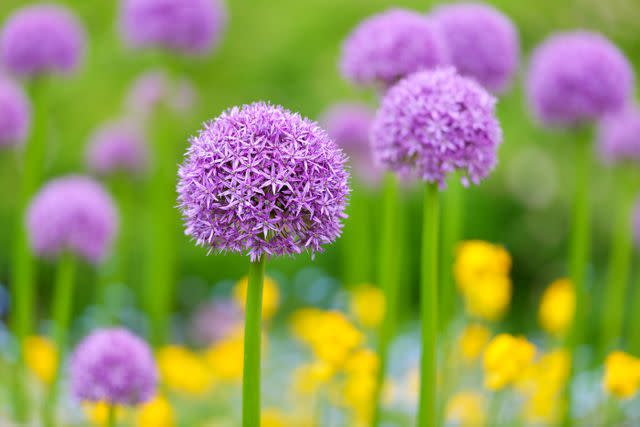
kongxinzhu / GETTY IMAGES
Martha grows allium, also called ornamental onion, on her estate in Bedford, N.Y. The plant comes in many sizes and shades of purple, so you're sure to find one suited to your space. "'Drum Stick allium' are 24 inches tall and bloom in a vibrant shade of purple," says PeggyAnne Montgomery, horticulturist and bulb expert for Flowerbulbs.com. "'Globemaster' is a giant, growing up to 5 feet tall with round flower heads 8 to 10 inches wide." No matter which one you plant, all allium are loved by bees, butterflies, and other pollinators—and are rabbit-, rodent-, and deer-resistant to boot.
Growing zones: 5 to 8
Size: 1 to 5 feet tall x 5 to 6 inches wide
Growing requirements: full sun to part shade; well draining soil
Crocus
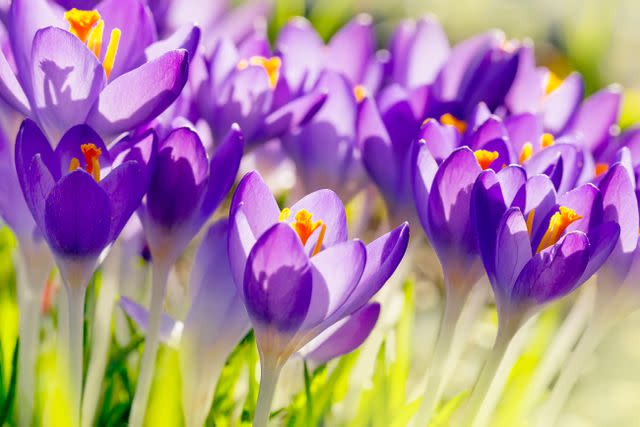
DuchesseArt / GETTY IMAGES
Consider planting crocus for an early display of spring blooms. The perennial plant comes in various shades of purple, from lavender and dark purple to purple-and-white stripes. "They can be planted in the lawn, in containers, and in beds and borders," says Montgomery. "Crocus is an important early season food source for pollinators like bees." Another bonus? Crocus flowers close up at night—and sometimes you can catch a bee sleeping inside when they open in the morning, says Montgomery.
Growing zones: 4 to 8
Size: 4 to 6 inches tall x 1 to 3 inches wide
Growing requirements: full sun to part shade; well draining soil
Verbena 'Homestead Purple'
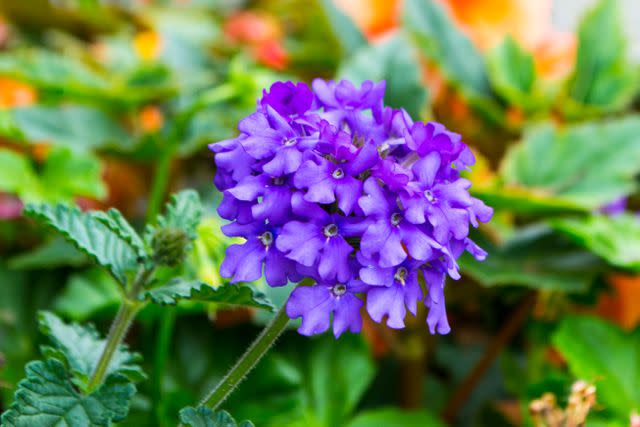
Houda Dekhla / GETTY IMAGES
There are many varieties of verbena that offer flowers in shades of purple, but 'Homestead Purple' (Verbena canadensis 'Homestead Purple') is a fan favorite. "This variety has been around for years and is somewhat hardy," says Adrienne Roethling, garden director for Paul J. Ciener Botanical Garden. "It also makes a great container plant." The violet-purple flowers are small and tubular and begin flowering in late May, lasting through your first frost. For best survival chances, plant this variety of verbena in spring for proper root establishment.
Growing zones: 7 to 9
Size: 6 inches tall x 36 inches wide
Growing requirements: full sun; well draining soil
Calla Lily
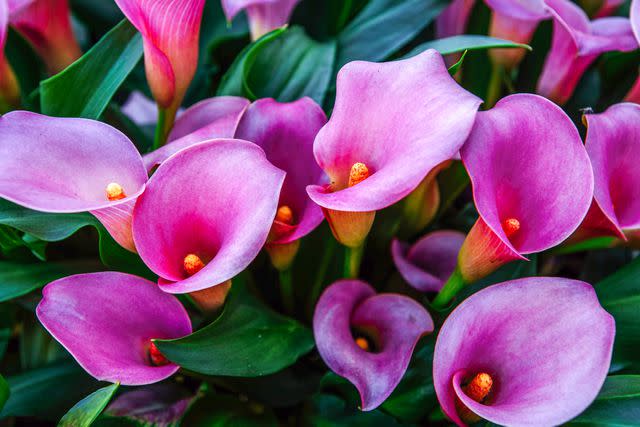
standret / GETTY IMAGES
Give your garden a tropical look by planting calla lilies (Zantedeschia aethiopica). "New varieties flower in the deepest shades of purple—nearly black," says Montgomery. "They bloom for weeks and are perfect for containers." Although they're not hardy in much of the United States, calla lilies can be dug up and stored in the fall or used as annuals. "Their price point is in line with other annuals, so I save myself the hassle and use them as annuals," says Montgomery. "When they are budded up, I bring the containers out and give them a prominent place in the garden."
Growing zones: 9 to 10
Size: 12 to 36 inches tall and 10 to 24 inches wide
Growing requirements: full sun to part shade; well draining soil
The Difference Between Perennial and Annual Plants
Persian Shield
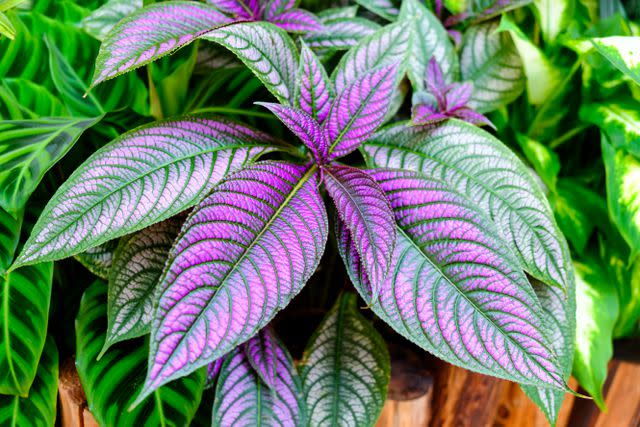
danielvfung / GETTY IMAGES
A popular tender perennial, Persian shield (Strobilanthes dyerianus) grows equally well in containers as it does in the ground. "It has been around for centuries and was a favorite during the Victorian era," says Roethling. "Persian shield has purple stems producing metallic purple leaves with darker purple veins." If growing in containers, the plant should be brought indoors during winter months where it will make a great houseplant.
Growing zones: 10 to 11
Size: 2 to 3 feet tall x 2 to 3 feet wide
Growing requirements: full sun; well draining soil
Hyacinth
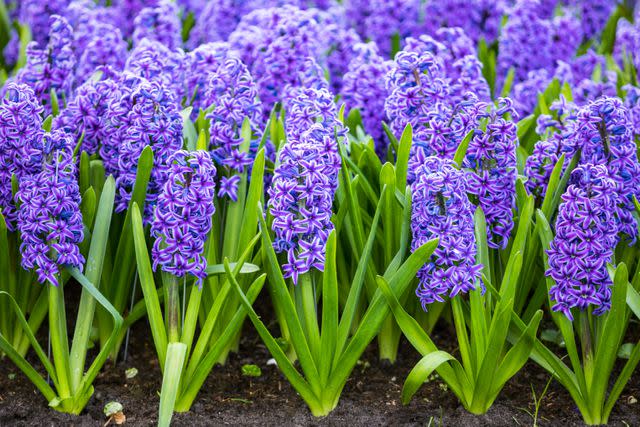
Adam Smigielski / GETTY IMAGES
Hyacinths (Hyacinthus) have been cultivated since the 17th century and have more than 2,000 varieties. "The flowers bloom in early spring and may bloom while there is still snow on the ground, making their saturated colors really pop," says Montgomery. "While each individual flower is small, they combine to make a statement when they bloom." Hyacinths are a great addition to any cut garden and will fill your home with a delightful scent.
Growing zones: 4 to 8
Size: 8 to 10 inches tall and 4 to 6 inches wide
Growing requirements: full sun to part shade; well draining soil
Weeping Redbud
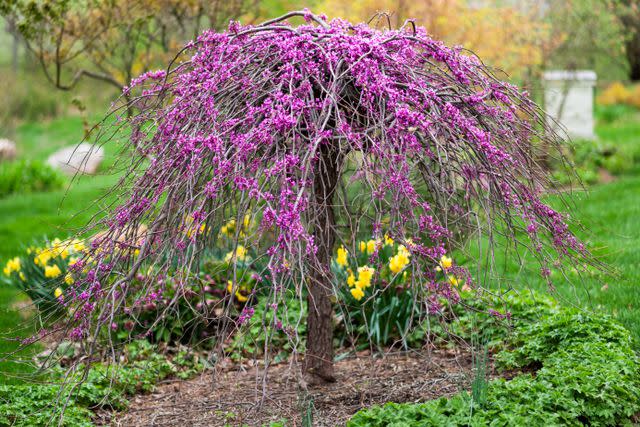
Stephanie D. Dudek / GETTY IMAGES
Native to the U.S., weeping redbud (Cercis canadensis) has several purple leaf varieties. "'Ruby Falls' is a perfect example of a weeping purple leaf redbud," says Roethling. "All other aspects of 'Ruby Falls' are indicative of typical redbud: zigzag stems, lavender flowers in early spring, and heart-shaped leaves." The leaves, which emerge in mid-spring, are burgundy purple and remain throughout the summer. "It's an ideal plant to grow over a wall or as a standalone plant; it offers a picturesque sight in the landscape," says Roethling.
Growing zones: 5 to 9
Size: 6 to 8 feet tall x 6 to 6 feet wide
Growing requirements: full sun; well draining soil
Tulip
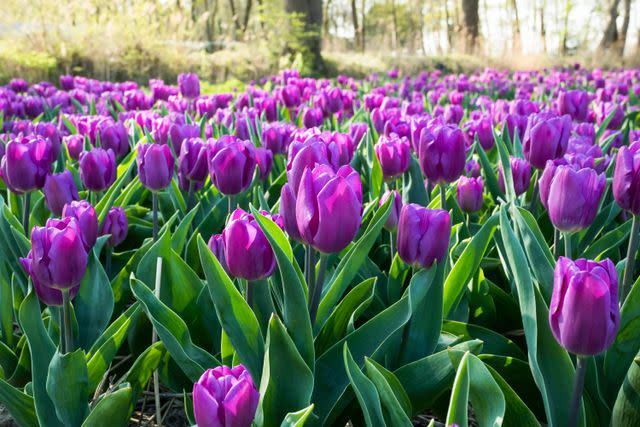
PicturePartners / GETTY IMAGES
One of the most recognizable flowers in the world and spring's earliest bloomers, tulips (Tulipa) are available in every shade of purple imaginable. "Some are light purple and some are a deep, vibrant purple," says Montgomery. "'Queen of the Night' is such a dark purple it is nearly black." In addition to the flower's wide color range, tulips are known for being low maintenance.
Growing zones: 3 to 7
Size: 12 to 28 inches tall x 1 to 2 inches wide
Growing requirements: full sun to part shade; well draining soil
Iris
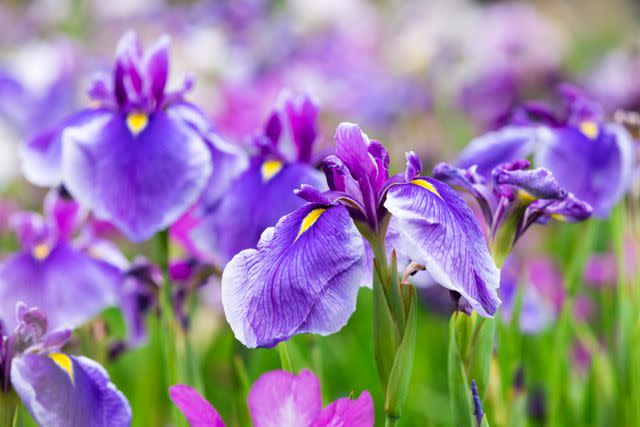
yumehana / GETTY IMAGES
No other plant family comes in more shades of purple than iris, says Montgomery. If you're looking for some ideas of a variety to grow in your own garden, Bearded iris, Siberian iris, and Japanese iris are all outstanding garden performers. "Unlike many plants, iris like to have their rhizomes at the top of the soil to get some sun and keep them dry," says Montgomery. "After blooming, cut the flower stem off down to the base but don't cut any leaves off—they need them to generate energy for the next year." As a cut flower, iris can last for four to seven days after being snipped.
Growing zones: 4 to 9
Size: 8 to 40 inches tall x 6 to 24 inches wide
Growing requirements: full sun to part shade; slightly acidic to neutral well draining soil
Gladiolus
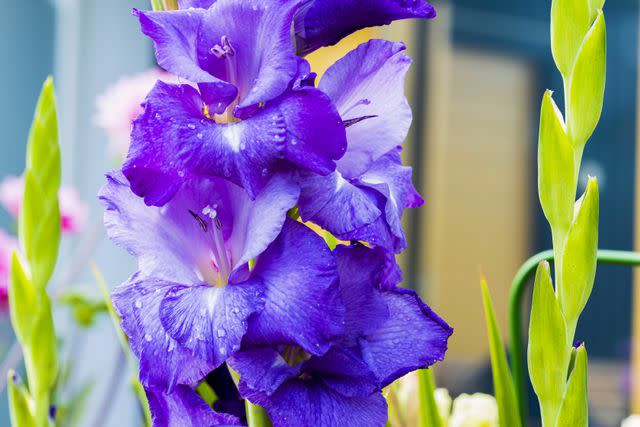
Alexander Shapovalov / GETTY IMAGES
A popular summer flower, gladiolus is available in a range of purple colors. "Some come in the deepest shade of purple, while some are purple with a white eye and everything in between," says Montgomery. Gladiolus typically requires staking because of its height. After blooming, be sure to cut back the flower stem—but not the foliage.
Growing zones: 3 to 10
Size: 30 to 50 inches tall x 1 foot wide
Growing requirements: full sun to part shade; well draining soil
Coleus 'Shiny Shoes'
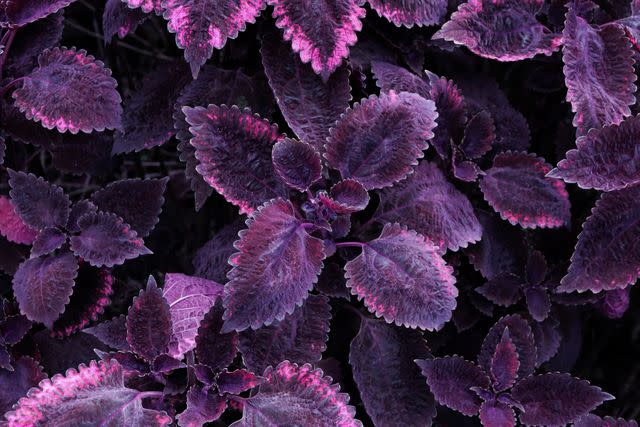
yuphayao phankhamkerd / GETTY IMAGES
Coleus 'Shiny Shoes' (Coleus scutellarioides 'Shiny Shoes') is an all-purple leafed variety that is best suited as a container plant. "The foliage is smaller on this one as well as the overall growth," says Roethling. "All coleus flower, but they are small tubular blue flowers on short stalks. The flowers offer a minimal show and most gardeners remove the spikes to promote more colorful leaves."
Growing zones: 11
Size: 12 inches tall x 12 inches wide
Growing requirements: full sun to part shade; well draining soil
Blazing Star
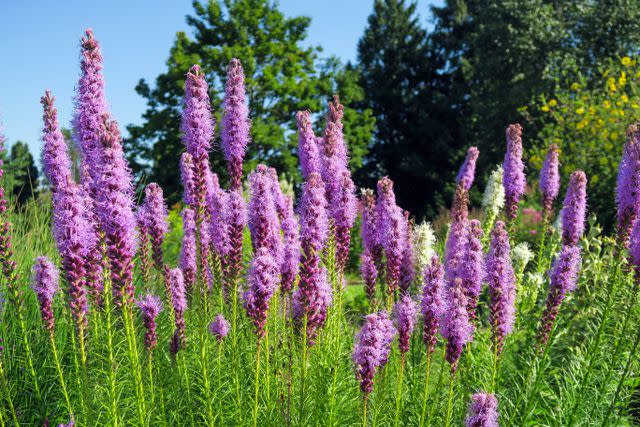
fotolinchen / GETTY IMAGES
Native plants, like blazing star (Liatris), are heroes in the garden—they're typically drought-tolerant, can attract pollinators, and are deer-resistant. "This U.S. native plant has neon-purple flowers," says Montgomery. "They bloom from top to bottom of the flower stem unlike almost every other flower that blooms from the bottom up." Blazing star is a great cut flower that looks beautiful when planted alongside other native plants, like beebalm and black-eyed Susans.
Growing zones: 3 to 9
Size: 2 to 4 feet tall x 1 to 2 feet wide
Growing requirements: full sun; well draining soil
Poppy 'Lauren's Grape'
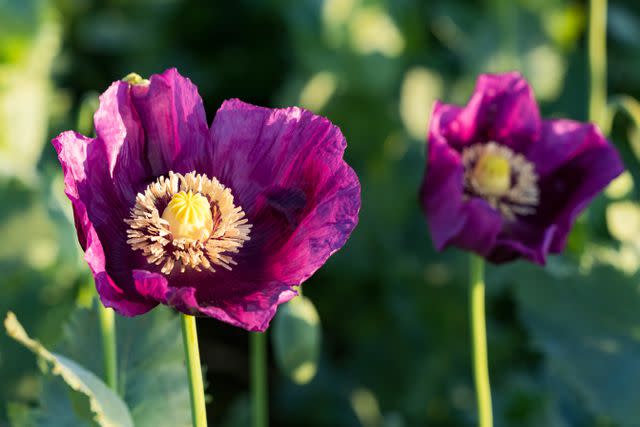
Landscapes, nature, macro / GETTY IMAGES
Poppy's come in many varieties, but Lauren's grape (Papaver somniferum 'Lauren's Grape') is Montgomery's favorite. "The purple color of the flowers demands attention," she says. "They are even more beautiful than their pictures." This type of poppy is easily grown from seed and should be planted in early spring as they need two to four weeks of cold to break dormancy.
Growing zones: 6 to 9
Size: 24 to 36 inches tall x 10 to 12 inches wide
Growing requirements: full sun to part shade; well draining soil

